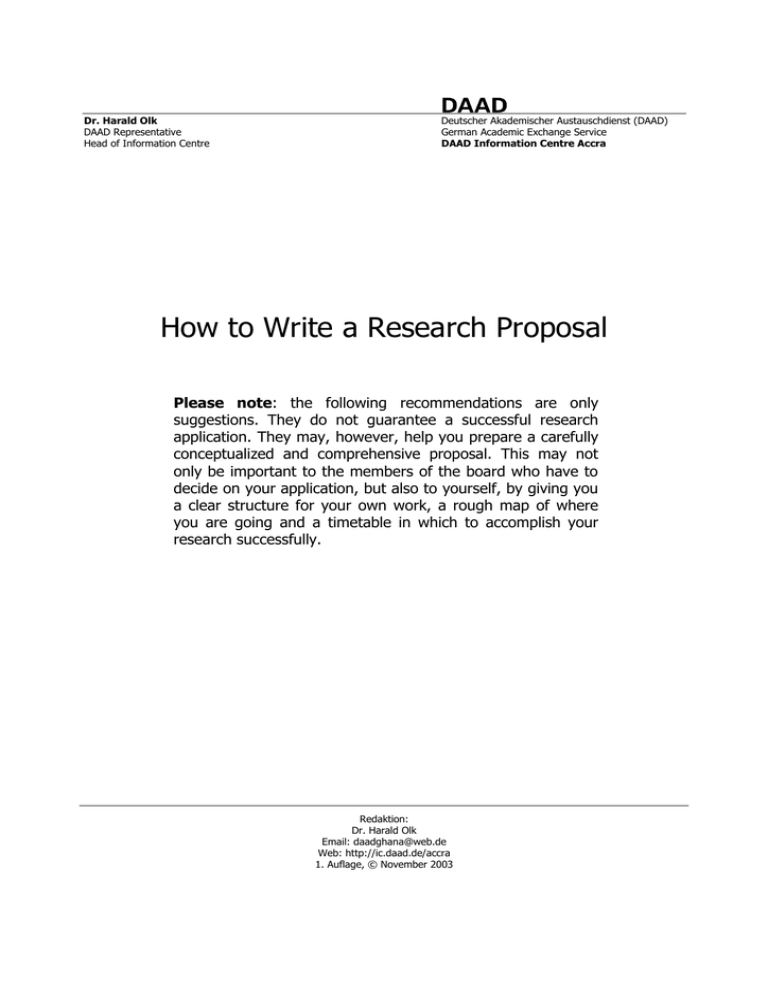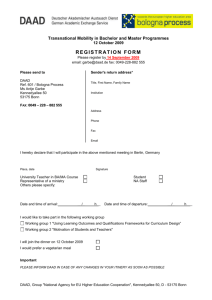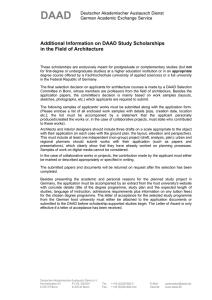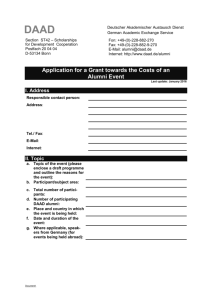How to Write a Research Proposal
advertisement

Dr. Harald Olk DAAD Representative Head of Information Centre Deutscher Akademischer Austauschdienst (DAAD) German Academic Exchange Service DAAD Information Centre Accra How to Write a Research Proposal Please note: the following recommendations are only suggestions. They do not guarantee a successful research application. They may, however, help you prepare a carefully conceptualized and comprehensive proposal. This may not only be important to the members of the board who have to decide on your application, but also to yourself, by giving you a clear structure for your own work, a rough map of where you are going and a timetable in which to accomplish your research successfully. Redaktion: Dr. Harald Olk Email: daadghana@web.de Web: http://ic.daad.de/accra 1. Auflage, © November 2003 DAAD Information Centre Accra How to Write a Research Proposal 1. Introduction When applying for a research grant or a study scholarship, the DAAD expects you to hand in a "detailed and precise description of study or research proposal as well as information on any previous study or research projects of particular relevance to a decision of award" (see application form, p. 5) What does that mean precisely? The intention of the proposal is to ensure that the candidates have done sufficient preliminary reading/research in the area of their choice, that they have thought about the issues involved and are able to provide more than a broad description of the topic which they plan to investigate. The proposal is of course not a fixed blueprint. One cannot predict one's findings beforehand or mechanically stick to an argument since the research will inevitably alter or even unseat one's initial expectations. There is no fixed formula for writing a proposal. Furthermore, academic traditions in Ghana and in Germany may differ slightly. The overall criteria, however, is: You have to convince members of the scientific community that you have identified a scientific problem as well as a theoretical background and methodical way to solve it within a realistic framework of time and expenses. With your research, you will add a new aspect to the scientific discussion. Your research proposal should have at least 3, but not more than about 10 pages. It should have an agreeable layout (typeface and line spacing) as well as a table of contents and page numbers. Remember that board members usually have to read a large number of research proposals. 2. Title Page On the title page, state your personal information like name, academic title (if applicable), your position at your own university, e.g. junior lecturer (if applicable), your date of birth, nationality, and your work and private address with telephone and e-mail. Then the title of your planned dissertation (or research report) should follow. Remember that at this stage, the title can only be a working title. Nevertheless, all words in the title should be chosen with great care, and their association with one another must be carefully managed. While the title should be brief, it should be accurate, descriptive and comprehensive, clearly indicating the subject of the investigation. Note that you will only be ready to devise a title when you are clear about the focus of the study. You should also state the area of your research, e.g. Political Science - Theory of International Relations - or Empirical Social Science etc. You should give a realistic time frame in which you plan to complete your project, followed by the name of your supervisor(s), the University Department where you hope to do your research and, if applicable, information about other academics with whom you plan to collaborate. DAAD Information Centre Accra How to Write a Research Proposal 3. Short Statement of the Problem Give a short summary of the research problem that you have identified - not more than 15 to 20 lines. Remember, the most important aspect of a research proposal is clarity on the research problem. You should choose a topic which can be investigated through appropriate and valid methods and for which research material is available. Your most difficult problem might be narrowing the topic. This often occurs with topics that are still relatively unfamiliar. Do a lot of general reading, and, if possible, consult with your supervisor. 4. Review of Research Literature Give a short and precise overview about the present state of research that is immediately connected with your own research project. Name the most important contributions of other scientists. The proposal should contain a clear and logical discussion of the theoretical framework or body of ideas that will be used to frame the research. The proposal needs to show that you are fully conversant with the ideas you are dealing with and that you grasp their methodological implications. Your research review should indicate an open problem which then will be the motive for your project. State clearly how your own research will contribute to the existing research. 5. Your own Preparatory Work Summarize the most important results of your own work on the topic (if applicable). Attach copies of your own publications that might be seen in connection with your research project. 6. Aim of the Research Project Give a concise and clear outline of the academic (possibly also non-academic, e.g. social and political) aims that you want to achieve through your project. Your proposal needs to show why the intended research is important and to justify the effort of doing the research. Here you outline the significance (theoretical or practical) or relevance of the topic. Such justification may either be of an empirical nature (you hope to add to, or extend an existing body of knowledge) or of a theoretical nature (you hope to elucidate contentious areas in a body of knowledge or to provide new conceptual insights into such knowledge). All research is part of a larger scholarly enterprise and candidates should be able to argue for the value and positioning of their work. DAAD Information Centre Accra How to Write a Research Proposal 7. Outline of your project This is the central part of your research outline. It may well fill half of the space of your proposal. You should give detailed information about your intended research procedure during the given time. Anyone who reads your proposal will want to know the sources and quality of evidence you will consult, the analytical technique you will employ, and the timetable you will follow. Depending on the topic, suitable research strategies should be defines to ensure that enough and adequate empirical data will be gathered for a successful research project. You will describe the intended methods of data gathering, the controls you will introduce, the statistical methods to be used, the type of literature or documentary analysis to be followed and so on. 8. Tentative Time Table Give, if possible in a table, information about your estimated time table, indicating the sequence of research phases and the time that you will probably need for each phase. Take into account that at this stage, it can only be estimated, but make clear that you have an idea about the time span that will be needed for each step. 9. Selective Research Bibliography Here you list those academic works which you have mentioned in your research outline as well as a number of other important works on which you will refer during your research. 10. Attachments Give a list of other documents attached to your proposal. 11. Editing Once you have finished conceptual work on your proposal, go through a careful editing stage, in which you make sure your proposal does not contain any grammatical/orthographical mistakes or typos. If possible, ask someone within the academic community to proofread your proposal in order to make sure the proposal conforms with international academic standards.


